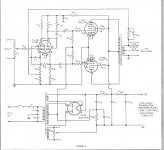Hi to everybody, can please someone here let me know if and how could be possible switch this PP Rca 30w to triode mode? I used 6L6GT,JJ and 6GH8A.
The only think I know is that I can disconnect the two 6L6 grid from the output transformer and connect with 100 ohm resistor to the plate, is that correct or there is some other correction to do? Thanks
The only think I know is that I can disconnect the two 6L6 grid from the output transformer and connect with 100 ohm resistor to the plate, is that correct or there is some other correction to do? Thanks
Attachments
That’s about it, connect the screen grids to the plates via resistors..
...and then find a new optimum operating point for output tubes to get the best linearity, i.e. lowest THD (if this matters). And also modify the GNFB loop components R18 and C6.
Thanks to everybody, I forgot to mention that I already removed from the beginning R18 and C6, really did not like the performance of the amp with the GNFB also I changed the C4,C5 increasing the value from the original 0,25 uF to 0,33 uF, so "DF96" I must also remove C2 R10?
really did not like the performance of the amp with the GNFB
Which part of the performance ?
THD, frequency response, S/N, transient response etc. ?
Or do you mean you did not like the "sound" ?
The performance of the amplifier can be measured (with test equipment).
Performance is not an opinion of the "sound" of an amplifier.
Last edited:
Then you have to keep on changing components and listen and change components...
By removing the GNFB you reduced the performance of the amplifier. THD increased, damping factor decreased, S/N decreased and frequency response became skewed. The amplifier is no more HIFI equipment. Nobody knows how to modify the amplifier to fulfill your taste.
By removing the GNFB you reduced the performance of the amplifier. THD increased, damping factor decreased, S/N decreased and frequency response became skewed. The amplifier is no more HIFI equipment. Nobody knows how to modify the amplifier to fulfill your taste.
Last edited:
In the schematic that I have is the same 270R and 0.01 uF 600v, when originally I built the amp whit the FB was like a generator injecting a strange sound in the amp so after several attempt disconnecting R18/C6 solved the problem but I really do not know why this, I am not an expertise just an hobbyist seeking some advise from expert people here...thanks
...when originally I built the amp whit the FB was like a generator injecting a strange sound in the amp so after several attempt disconnecting R18/C6 solved the problem but I really do not know why this, ....
If it was a loud buzzing squeal, that sound happens when the polarity of the FB is backward. You can reverse swap the plate leads to the OPT or you can change the grounded speaker terminal to the other (+) side. That will reverse the FB polarity.
I have never seen a cap that large in value used for FB, more like .001 uF. You can disconnect the cap and leave the resistor in place. The 270R resistor is very low, also. It provides high FB level that is dropped at the 10R resistor. You could increase the FB resistor value to 470R or higher to try a little less FB.
You need to think about ratios rather than absolute values.20to20 said:I have never seen a cap that large in value used for FB, more like .001 uF. You can disconnect the cap and leave the resistor in place. The 270R resistor is very low, also. It provides high FB level that is dropped at the 10R resistor. You could increase the FB resistor value to 470R or higher to try a little less FB.
The cap is high in value because the resistor is low in value. What matters is the product CR, because this sets the HF rolloff.
The resistor is low in value because the feedback injection point resistor is also low in value. It is the ratio of these two (27) which sets the feedback; 27 is a perfectly normal feedback ratio; many amps are in the region of 30 for this figure.
Omitting the cap may cause instability.
- Status
- This old topic is closed. If you want to reopen this topic, contact a moderator using the "Report Post" button.
- Home
- Amplifiers
- Tubes / Valves
- How to convert PP RCA 30w to triode mode
